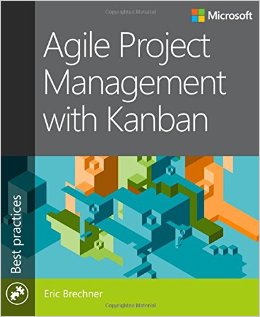
Agile Project Management with Kanban
In zijn boek ‘Agile Project Management with Kanban’ deelt Eric Brechner zijn ervaringen met de introductie en het gebruik van Kanban bij het Microsoft Xbox platform. Hij borduurt voort op de groeiende populariteit van Kanban sinds 2010. Zijn doelgroep bestaat uit professionals van alle disciplines in software engineering met interesse voor praktische toepassing. Lezen en daarna zelf doen is zijn credo.
Voor sommigen zal de naam Eric Brechner bekend klinken, dat klopt. Eric Brechner is de auteur van het in 2007 verschenen boek ‘Hard Code’: een bundeling van interne columns over de softwareontwikkeling binnen Microsoft verschenen onder het pseudoniem I.M. Wright. Nu is hij terug met ‘Agile Project Management with Kanban’ en publiceert hij onder eigen naam. In zijn nieuwe boek staat het gebruik van Kanban bij zijn teams van Xbox bij Microsoft centraal.
Zonder er om heen te draaien wijst Brechner er in de inleiding op dat het boek bedoeld is voor professionals die geïnteresseerd zijn in een praktische toepassing van Kanban. Ben je op zoek naar meer achtergrondinformatie over de theorie en fundamentele uitgangspunten van Kanban, dan zijn er betere alternatieven.
- Brechner gebruikt het eerste hoofdstuk om het gebruik van Kanban in een organisatie te introduceren. Het is met name gericht op het overtuigen van management en bevat naast de argumentatie tevens een voorbeeldmemo ter ondersteuning.
- In het tweede hoofdstuk neem hij de lezer in 5 stappen mee in het opzetten van Kanban. Hij geeft voldoende informatie en handvatten om direct zelf aan de slag te gaan. Elegant kort is zijn vergelijking tussen Kanban-Scrum-Waterval en de wijze waarop deze technieken chaos beperken in stap 3 van het stappenplan. De uitleg over het gebruik van limieten aan Work in Progress en de werkwijze van het Kanbanbord is helder.
- De volgende hoofdstukken behandelen specifieke onderwerpen gericht op verschillende organisatorische kenmerken. Hoofdstuk 3 richt zijn pijlen op het halen van deadlines – een terugkerende uitdaging in softwareontwikkeling – en het informeren van management omtrent planning en de inzet van schattingstechnieken.
- Hoofdstuk 4 geeft een korte beschrijving van de introductie van Kanban bij een team dat de Waterval-methode gebruikt. Zonder grote verassingen neemt hij mogelijke weerstanden weg en focust hij zich met name op de voordelen van de transitie van Waterval naar Kanban.
- De inhoud van het volgende hoofdstuk roept bij Scrum-professionals een aantal vragen en vermoedelijk enige weerstand op, namelijk het vervangen van Scrum door Kanban. De voordelen van Kanban ten opzichte van Scrum zijn vrij summier beschreven. Brechner waardeert Scrum zeker, hij waardeert Kanban nog meer. Tekenend is zijn statement dat ‘Kanban de volgende evolutie van Scrum is’. Dit is natuurlijk, niet geheel onterecht, voer voor discussies met Scrum-aanhangers.
- Hoofdstuk 6 is redelijk technisch ingestoken en geeft een beknopte beschrijving van de inzet van verschillende branching, versioning en deployment strategieën. De interessante link met Kanban zijn de aanpassingen die hij inzet op het Kanbanbord en de gehanteerde flows.
- Het opschalen van Kanban naar grotere organisaties, zoals Microsoft, vraagt om extra aanpassingen. Aan dit onderwerp besteedt hoofdstuk 7 aandacht. Brechner tackelt bekende problemen bij opschalen zoals communicatie en afhankelijkheden tussen teams. De verschillende manieren om volgordelijkheden tussen teamactiviteiten inzichtelijk te maken zijn naast leerzaam, ook zeker in andere Agile-frameworks toepasbaar.
- Hoofdstuk 8 is geschreven door James Waletzky, een ervaren software engineer die voorheen werkzaam was in de Xbox teams. Hij beschrijft de integratie van het werken aan bugs met de doorontwikkeling van een product. Deze twee aspecten staan vaak op gespannen voet, vandaar de extra aandacht in een apart hoofdstuk. Voor diegenen die in productdevelopment werkzaam zijn, zijn de ‘troubleshooting’ voorbeelden zeer herkenbaar.
- Het laatste hoofdstuk, behandelt uitbreiding van Kanban met andere methodes en technieken zoals Lean, Theory of Constraints of Critical Chain. Dit hoofdstuk is met name bedoeld voor meer ervaren teams die de basisflow in de vingers hebben en zoeken naar verdere optimalisaties.
Per hoofdstuk zijn praktische checklist toegevoegd en bij een aantal hoofdstukken zijn interessante vraag-antwoord voorbeelden opgenomen. Met name de voorbeelden bereiden de lezer voor op vragen van mogelijke klanten, managers of teamgenoten. Nuttig om te weten is dat de rekenvoorbeelden en het genoemde memo online beschikbaar zijn. Hiermee heeft de lezer direct één op één de voorbeelden uit het boek te pakken.
Brechner’s achtergrond als engineer verklaart wellicht het veelvuldig gebruik van checklists, tips, formules en voorbeelden. Hoewel de gebruikte formules en voorbeelden niet complex zijn, lees je dit boek waarschijnlijk niet in één adem uit. Dat hoeft ook niet. De gekozen opzet, met hoofdstukken gericht op specifieke situaties, geeft de lezer de mogelijkheid snel door te bladeren naar de voor hem of haar relevante onderdelen.
Heb je behoefte aan een praktische leidraad in Kanban of ben je nieuwsgierig naar het ontwikkelproces bij een top gaming platform & multinational zoals Microsoft – dan ben je met Agile Project Management with Kanban aan het juiste adres.
Over deze recensie
Deze boekrecensie is tevens verschenen op www.managementboek.nl. Aangezien het betreffende boek in het Engels is, is een Engelse recensie wellicht passender. Bij voldoende tijd zal ik hem alsnog vertalen.
Cheers,
– Sjors Meekels
Note in English
This book review is in Dutch and is also published on www.managementboek.nl. The book is in English so it would make sense to write an English review. Again, when I do have some spare time I will make a translation
Filled Under: agile,book review,kanban,scrum,software development Posted on: 21 June 2016

